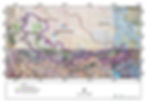
PEAK WILDERNESS AREA & BOGAWANTALAWA VALLEY
This research is what informed our Corridors for Conservation initiative. Please refer to that for updates.
Update 2022: Work in this region is continuing, and over the past 5 years we have monitored 34 different leopards within the PRFC, with an average of 8-15 individuals at any given time. The need, now, is to improve the overall PRFC habitat through re-forestation. Two partner plantation companies have agreed to establish nurseries on their estates to help achieve this goal.
We have also started conservation efforts in the Western Ridge and the Elbedda Ridge, working to establish the leopard population and movement patterns in these areas. These ridgelines are similar to the PRFC and, working with partner estates, we hope to establish them as Forest Corridor conservation areas.
Our early work in the southern Central Highlands of Sri Lanka, and the larger Bogawantalawa Valley area (bordering the Peak Wilerness Sanctuary to the east), confirmed the presence of high biodiversity in this region. It is a key watershed comprising of a mixed montane landscape, including tea, other plantation land, grassland and forest. Not only have we monitored endemic and critically endangered species, but also the frequent use of Sri Lanka’s small wild cats (the fishing cat and the rusty-spotted cat) in this region. Importantly, we have also established that the island’s apex predator – the leopard – uses this area as movement corridors between the larger Peak Wilderness forests, and as an additional residential refuge. Therefore, the WWCT continues its research and monitoring of this largely unprotected landscape.
The WWCT’s Ongoing work
Our continued monitoring confirms the residency of leopards here, with females using these ridges as resident refuges while males use the larger landscape as movement corridors to move between and access them. To date, six permanent remote camera stations have been established to monitor the activities of these ridge leopards. In addition to leopard movement, the long-term tenure by leopards, cub rearing timelines, recruitment, and leopard diet analysis are also ongoing. The continued documentation of Sri Lanka’s other wild cats in this region, together with general mammal biodiversity, is also a continuing goal of our work.
A study population of ~15 individual leopards are under long-term monitoring within the specific ridge area that we have now called the Peak Ridge Forest Corridor (see below). As of December 2020, the resident population consists of 4 males, 5 females and their varied cubs that actively live on and use this Peak Ridge area.
COVID-19 Complications
Unfortunately, due to the ongoing Covid-19 situation and lockdowns, there has been a proliferation in the use of trap snares in the Central Highland area, resulting in the incidental trapping of leopards, and even the death of a rare, black leopard. Luckily, our resident leopards have not, to date, fallen prey to these insidious trap snares. Another consequence of the lockdowns and the lack of WWCT presence has been the damage and theft of project equipment, limiting the areas in which photo capture can occur, and compromising the leopard monitoring data. To manage these new complications, the WWCT has posted signs, locally, warning of the illegalities of using snares and setting fires, for the preservation of the land and its wildlife, while also notifying the public of an ongoing biodiversity project, to hopefully prevent further theft of equipment.
The Establishment of the Peak Ridge Forest Corridor
The most important outcome of this research has been the action of bringing together partner estates to create the Peak Ridge Forest Corridor: A conservation zone that runs along the top ridge between the Maskeliya and Castlereigh reservoirs and has 13 estates that back onto it. This is also the area that is a large portion of the home range of the resident population of leopards that we have documented.
The WWCT is in the process of replanting a 7-acre plot of released tea land and degraded forest, to improve habitat quality and to encourage a more effective buffer for this conservation zone. The planting of forest species is underway on the first acre of land on the Dunkeld estate.
A dedicated forest plant nursery which is housing several forest plant species for the purpose of this initiative has also been established, and it is the hope that bordering estates will contribute to the rehabilitation of the forest around the Peak Ridge Corridor so as to increase the level of protection it provides to wildlife.
It is vital that we afford these largely unprotected lands protection and improve the habitat within these ridge areas. The Peak Ridge Forest Corridor, hopefully, will be one of many that will be established to afford these highland leopards the refuge they require and at the same time allow for improved human-wildlife coexistence and better watershed management.
The WWCT has begun work monitoring the two adjacent ridge areas, to attempt to identify the leopard population land-use patterns and thereby specifically identify the conservation zones for protection.
For a more detailed account of the work in this area, please see the reports below.







